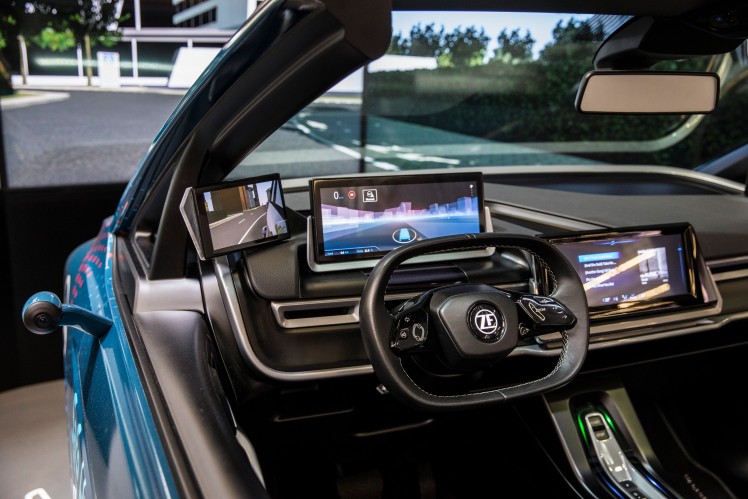New Best Friends: Human and Electronic Drivers Understand Each Other Very Well Indeed, Thanks to ZF - In the Safe Human Interaction Cockpit, humans and on-board systems interact intuitively to help enhance comfort and safety
- The ZF system can automatically adjust the seat position to suit each driver, letting them get in and out of the vehicle in comfort
- Enhanced safety is achieved through seamless and easy operation of complex assistance systems
Friedrichshafen / Frankfurt am Main. In the Safe Human Interaction Cockpit (SHI Cockpit) made by ZF in partnership with Faurecia, advanced assistance systems and automated driving functions communicate with the driver simply and effectively. The goal is enhanced vehicle safety and comfort from the point of departure to the destination.

Transfers of control between man and machine are performed unobtrusively and intuitively. The seat can adjust automatically to suit all kinds of driver across a wide variety of situations. The vehicle provides feedback on control interventions in a clear, transparent, and unambiguous way. Thanks to intelligent electronic assistance they are also easy to adjust.
There is often a wide gulf between the potential safety and convenience enhancements that could be achieved by automated driving systems and the perception of the personal vehicle user of how these systems will work. The SHI Cockpit dispels this discrepancy. “It really does simplify the handover scenarios between humans and machines”, states Uwe Class, Director of Safe Mobility Systems in the corporate Advanced Engineering department at ZF. “Furthermore, drivers are kept in the picture about which driving mode is active at any given time. This increases the acceptance level for these important functions.”
Clear task assignment
First of all, the SHI Cockpit advises when road traffic conditions permit automated driving. The vehicle can take over as soon as the driver lets go of the steering wheel. This is sensed by a Hands-On-Detection (HOD) function within the steering wheel system and the wheel also rises and retracts forward, but remains within range. Thanks to steer by wire, the steering wheel remains stationary in this driving mode, rather than continuing to track the wheel movements. At the same time, the seat moves backward and downward, and inclines to a steeper angle. To enable it to do so, the seat has an extended range of adjustment.
“Nonetheless, safety remains at a high level because our airbags, the active seat belt, and the active seat-belt clip are integrated in the seat in the SHI Cockpit,” explains Class.
The vehicle uses a number of other methods in addition to the automatic change in seat position to inform the driver that either they have control responsibility or the vehicle does:
Depending on the situation, the SHI Cockpit combines haptic (e.g. vibrating seat belt), visual (e.g. circulating strip of cockpit lights that vary in color), and acoustic (sounds, voice) information. In reverse sequence, the SHI Cockpit can give the driver advance notice to resume control of driving the vehicle. If the driver fails to respond, the vehicle can be programmed to stop once reaching the safest position possible.
Taking a seat comfortably and safely
The SHI Cockpit promotes comfort and safety even before the journey begins. To make it more comfortable to board the vehicle, the seat receives the driver in a retracted, inclined position. Furthermore, the flattened steering wheel moves upward and rotates. Once the driver is seated, a 3-D interior camera measures the driver’s height and individually adjusts the seat and the steering wheel to match that person when driving manually. To allow the driver to leave the vehicle, the seat moves back to a suitable position. “The combination of ZF and Faurecia products solutions offer the best possible comfort for the users during ingress and egress,” states Eric Vanel, System & Mechanical Integration Director in the Cockpit of the Future department at Faurecia.
Creates confidence in assistants
The SHI Cockpit also groups all the assistance and feedback control functions on just one operator and display level. Drivers have a bird’s-eye view of their vehicles on the Head-Up Display Instrument Cluster (HUDIC), which is a monitor that is installed centrally.
The Active Vehicle Aura (AVA) signifies the effective networking of all assistance systems, for example adaptive cruise control, blind-spot warnings, and lane keeping assist. On the display, up to three oval lines depict the situation around the virtual vehicle. Total sensitivity can be set by just one finger on the steering wheel. Three lines signify early, gentle intervention. Just one oval signifies feedback control being applied later, and more forcefully. In potentially dangerous situations, the lines can change color and shape, for example, if the driver initiates a lane change when another road user is just behind the vehicle in its blind spot. Parallel to this, the assistants are capable of intervention to correct this critical maneuver. “No matter whether you are driving, or letting the car drive itself, our SHI Cockpit makes communication with complex systems so simple that it is self-evident and understandable,” states Class. “This enables assistance systems and automated driving functions to be perceived as the best friends that they, viewed objectively, already are.”
Comprehensive approach
ZF developed the SHI Cockpit in close cooperation with fka and Faurecia. ZF holds overall responsibility for the project, and developed and networked all of the new functions. ZF also contributed to all of the active and passive safety systems as well as to the HOD steering wheel (including vehicle motion control by steer by wire) and to advanced control elements. In close cooperation with fka Forschungsgesellschaft Kraftfahrwesen mbH Aachen, this concept is being tested in practical situations on a continuous basis. Aspects of perception psychology are also incorporated here. Examples include noise and sound design as well as the results of other test studies with individuals. ZF is cooperating with Faurecia for the integration of the restraint systems into the seat and the design of the cockpit elements.
- In the Safe Human Interaction Cockpit, humans and on-board systems interact intuitively to help enhance comfort and safety
- The ZF system can automatically adjust the seat position to suit each driver, letting them get in and out of the vehicle in comfort
- Enhanced safety is achieved through seamless and easy operation of complex assistance systems
Friedrichshafen / Frankfurt am Main. In the Safe Human Interaction Cockpit (SHI Cockpit) made by ZF in partnership with Faurecia, advanced assistance systems and automated driving functions communicate with the driver simply and effectively. The goal is enhanced vehicle safety and comfort from the point of departure to the destination.

Transfers of control between man and machine are performed unobtrusively and intuitively. The seat can adjust automatically to suit all kinds of driver across a wide variety of situations. The vehicle provides feedback on control interventions in a clear, transparent, and unambiguous way. Thanks to intelligent electronic assistance they are also easy to adjust.
There is often a wide gulf between the potential safety and convenience enhancements that could be achieved by automated driving systems and the perception of the personal vehicle user of how these systems will work. The SHI Cockpit dispels this discrepancy. “It really does simplify the handover scenarios between humans and machines”, states Uwe Class, Director of Safe Mobility Systems in the corporate Advanced Engineering department at ZF. “Furthermore, drivers are kept in the picture about which driving mode is active at any given time. This increases the acceptance level for these important functions.”
Clear task assignment
First of all, the SHI Cockpit advises when road traffic conditions permit automated driving. The vehicle can take over as soon as the driver lets go of the steering wheel. This is sensed by a Hands-On-Detection (HOD) function within the steering wheel system and the wheel also rises and retracts forward, but remains within range. Thanks to steer by wire, the steering wheel remains stationary in this driving mode, rather than continuing to track the wheel movements. At the same time, the seat moves backward and downward, and inclines to a steeper angle. To enable it to do so, the seat has an extended range of adjustment.
“Nonetheless, safety remains at a high level because our airbags, the active seat belt, and the active seat-belt clip are integrated in the seat in the SHI Cockpit,” explains Class.
The vehicle uses a number of other methods in addition to the automatic change in seat position to inform the driver that either they have control responsibility or the vehicle does:
Depending on the situation, the SHI Cockpit combines haptic (e.g. vibrating seat belt), visual (e.g. circulating strip of cockpit lights that vary in color), and acoustic (sounds, voice) information. In reverse sequence, the SHI Cockpit can give the driver advance notice to resume control of driving the vehicle. If the driver fails to respond, the vehicle can be programmed to stop once reaching the safest position possible.
Taking a seat comfortably and safely
The SHI Cockpit promotes comfort and safety even before the journey begins. To make it more comfortable to board the vehicle, the seat receives the driver in a retracted, inclined position. Furthermore, the flattened steering wheel moves upward and rotates. Once the driver is seated, a 3-D interior camera measures the driver’s height and individually adjusts the seat and the steering wheel to match that person when driving manually. To allow the driver to leave the vehicle, the seat moves back to a suitable position. “The combination of ZF and Faurecia products solutions offer the best possible comfort for the users during ingress and egress,” states Eric Vanel, System & Mechanical Integration Director in the Cockpit of the Future department at Faurecia.
Creates confidence in assistants
The SHI Cockpit also groups all the assistance and feedback control functions on just one operator and display level. Drivers have a bird’s-eye view of their vehicles on the Head-Up Display Instrument Cluster (HUDIC), which is a monitor that is installed centrally.
The Active Vehicle Aura (AVA) signifies the effective networking of all assistance systems, for example adaptive cruise control, blind-spot warnings, and lane keeping assist. On the display, up to three oval lines depict the situation around the virtual vehicle. Total sensitivity can be set by just one finger on the steering wheel. Three lines signify early, gentle intervention. Just one oval signifies feedback control being applied later, and more forcefully. In potentially dangerous situations, the lines can change color and shape, for example, if the driver initiates a lane change when another road user is just behind the vehicle in its blind spot. Parallel to this, the assistants are capable of intervention to correct this critical maneuver. “No matter whether you are driving, or letting the car drive itself, our SHI Cockpit makes communication with complex systems so simple that it is self-evident and understandable,” states Class. “This enables assistance systems and automated driving functions to be perceived as the best friends that they, viewed objectively, already are.”
Comprehensive approach
ZF developed the SHI Cockpit in close cooperation with fka and Faurecia. ZF holds overall responsibility for the project, and developed and networked all of the new functions. ZF also contributed to all of the active and passive safety systems as well as to the HOD steering wheel (including vehicle motion control by steer by wire) and to advanced control elements. In close cooperation with fka Forschungsgesellschaft Kraftfahrwesen mbH Aachen, this concept is being tested in practical situations on a continuous basis. Aspects of perception psychology are also incorporated here. Examples include noise and sound design as well as the results of other test studies with individuals. ZF is cooperating with Faurecia for the integration of the restraint systems into the seat and the design of the cockpit elements.
MEDIA
CONTACT

Florian Stemmler

